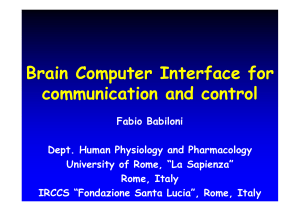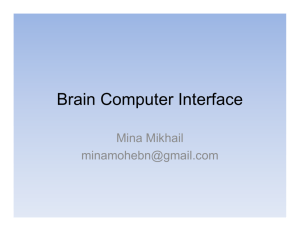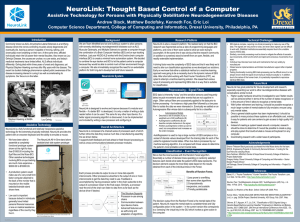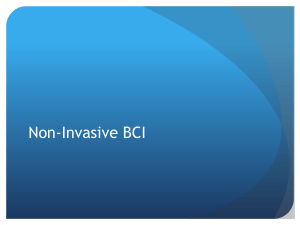A Review of Brain Computer Interface Ms Priyanka D. Girase
advertisement
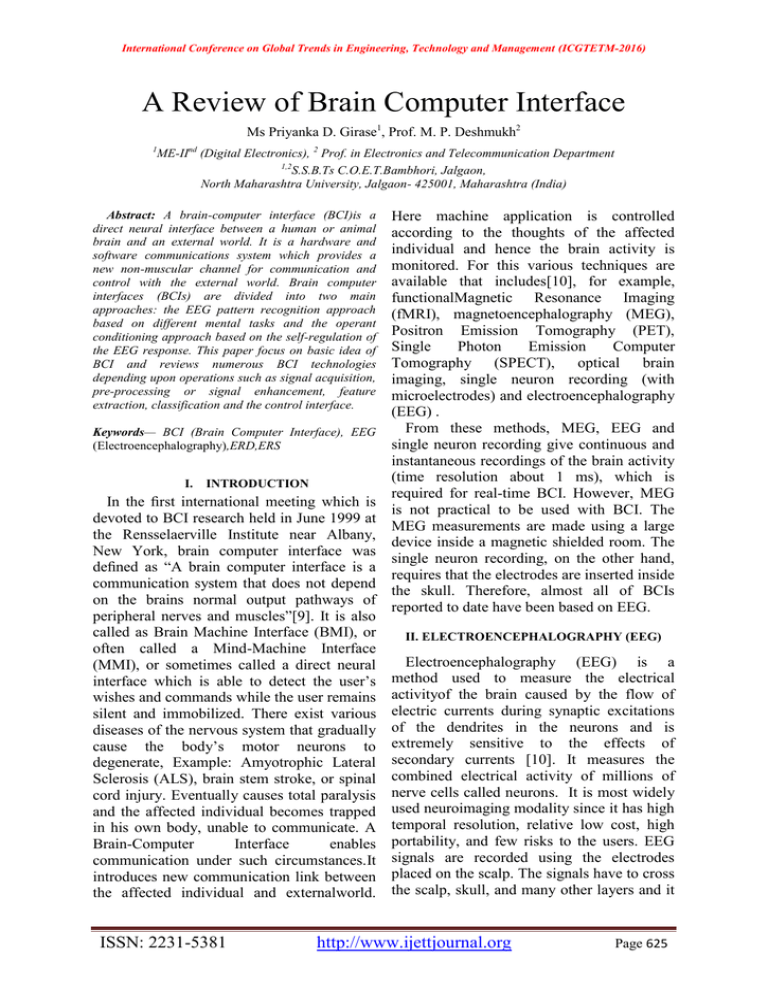
International Conference on Global Trends in Engineering, Technology and Management (ICGTETM-2016) A Review of Brain Computer Interface Ms Priyanka D. Girase1, Prof. M. P. Deshmukh2 1 ME-IInd (Digital Electronics), 2 Prof. in Electronics and Telecommunication Department 1,2 S.S.B.Ts C.O.E.T.Bambhori, Jalgaon, North Maharashtra University, Jalgaon- 425001, Maharashtra (India) Abstract: A brain-computer interface (BCI)is a direct neural interface between a human or animal brain and an external world. It is a hardware and software communications system which provides a new non-muscular channel for communication and control with the external world. Brain computer interfaces (BCIs) are divided into two main approaches: the EEG pattern recognition approach based on different mental tasks and the operant conditioning approach based on the self-regulation of the EEG response. This paper focus on basic idea of BCI and reviews numerous BCI technologies depending upon operations such as signal acquisition, pre-processing or signal enhancement, feature extraction, classification and the control interface. Here machine application is controlled according to the thoughts of the affected individual and hence the brain activity is monitored. For this various techniques are available that includes[10], for example, functionalMagnetic Resonance Imaging (fMRI), magnetoencephalography (MEG), Positron Emission Tomography (PET), Single Photon Emission Computer Tomography (SPECT), optical brain imaging, single neuron recording (with microelectrodes) and electroencephalography (EEG) . From these methods, MEG, EEG and Keywords— BCI (Brain Computer Interface), EEG single neuron recording give continuous and (Electroencephalography),ERD,ERS instantaneous recordings of the brain activity (time resolution about 1 ms), which is I. INTRODUCTION required for real-time BCI. However, MEG In the first international meeting which is is not practical to be used with BCI. The devoted to BCI research held in June 1999 at MEG measurements are made using a large the Rensselaerville Institute near Albany, device inside a magnetic shielded room. The New York, brain computer interface was single neuron recording, on the other hand, defined as “A brain computer interface is a requires that the electrodes are inserted inside communication system that does not depend the skull. Therefore, almost all of BCIs on the brains normal output pathways of reported to date have been based on EEG. peripheral nerves and muscles”[9]. It is also called as Brain Machine Interface (BMI), or II. ELECTROENCEPHALOGRAPHY (EEG) often called a Mind-Machine Interface Electroencephalography (EEG) is a (MMI), or sometimes called a direct neural method used to measure the electrical interface which is able to detect the user’s wishes and commands while the user remains activityof the brain caused by the flow of silent and immobilized. There exist various electric currents during synaptic excitations diseases of the nervous system that gradually of the dendrites in the neurons and is cause the body’s motor neurons to extremely sensitive to the effects of degenerate, Example: Amyotrophic Lateral secondary currents [10]. It measures the Sclerosis (ALS), brain stem stroke, or spinal combined electrical activity of millions of cord injury. Eventually causes total paralysis nerve cells called neurons. It is most widely and the affected individual becomes trapped used neuroimaging modality since it has high in his own body, unable to communicate. A temporal resolution, relative low cost, high Brain-Computer Interface enables portability, and few risks to the users. EEG communication under such circumstances.It signals are recorded using the electrodes introduces new communication link between placed on the scalp. The signals have to cross the affected individual and externalworld. the scalp, skull, and many other layers and it ISSN: 2231-5381 http://www.ijettjournal.org Page 625 International Conference on Global Trends in Engineering, Technology and Management (ICGTETM-2016) provides very poor quality signals. This means that EEG signals in the electrodes are weak, hard to acquire and of poor quality. This brain signals are severely affected by background noise generated either inside the brain or externally over the scalp. There exist various properties in EEG [9], which can be used as a basis of classification of the brain signals for a BCI as: A. Rhythmic Brain Activity Depending on the level of consciousness, normal people’s brain waves show different rhythmic activity. For instance, the different sleep stages can be seen in EEG.Different rhythmic waves also occur during the waking state. These rhythms are affected by different actions and thoughts, for example the planning of a movement can block or attenuate a particular rhythm. The fact that mere thoughts affect the brain rhythms can be used as the basis for the BCI.The EEG can be divided into several frequency ranges. Delta, theta, alpha, beta and gamma are the names of the different EEG frequency bands which is related to various brain states.In fig 1 the EEG waves for different frequency ranges are shown. So EEG is described in terms of frequency band in which each rhythm has some specified range of frequency as listed in table I Table IList of EEG Rhythms with frequency range Rhythm Delta (δ) Theta (Ɵ) Alpha ( ά) Beta (ß) Gamma (γ) Mu (µ) Frequency(Hz) 0.1 – 3.5 4 - 7.5 8 – 13 13 – 30 30 – 100 Around 10 B. Event-Related Potentials (ERPs) Event-related potentials are a common title for the potential changes in the EEG that occur in response to a particular “event” or a stimulus. These changes are so small that in orderto reveal them, EEG samples have to be averaged over many repetitions. This removes the “random” fluctuations of the EEG, which are not stimulus-locked. Event-related potentials can be divided into exogenous and endogenous. Exogenous ERPs occur up to about 100 ms after the stimulus onset. They depend on the properties of physical stimulus (intensity, loudness etc.). The potentials from 100 ms onward are called endogenous. They depend largely on psychological and behavioural processes related to the event. 3. Event-Related Desynchronization (ERD) and Event-Related Synchronization (ERS) Fig.1 EEG Waves over different Frequency Ranges ISSN: 2231-5381 ERD is an amplitude attenuation of a certain EEG rhythm. ERS is an amplitude enhancement of a certain EEG rhythm.The imagination of motor tasks produce measurable changes on the on-going EEG and represents frequency specific changes of the which can either be an increase in power (ERS) or a decrease in power (ERD). Traditionally, ERD is measured through the estimation of EEG signal power in specific frequency bands. So a certain motor task induces ERD over the corresponding cortical area while there is ERS in unrelated areas. The ERD/ERS is the fundamental http://www.ijettjournal.org Page 626 International Conference on Global Trends in Engineering, Technology and Management (ICGTETM-2016) physiological property which can be used as translate these features into appropriate a basis of classification of mental tasks in a device commands to take particular action. BCI system based on motor tasks. The application machine can be wheelchair, robotic arm, cursor, speller or any other III. BRAIN COMPUTER INTERFACE device as shown in fig 2. Brain Computer Interface (BCI) [1], technology is a new and fast evolving field that measures the specific features of brain activity and translates them into device control signals. Signal is acquired using the electrodes on the scalp. These signals are weak hence amplified and are converted into digital form. Then features are extracted from amplified and digitized version of EEG signals in the signal processing stage.In this stage useful EEG data is separated from noise. The modern BCIs often use several types of feature extraction such as Hjorth Fig. 2 Brain Computer Interface parameters wavelet transforms, Fourier transforms, and various other types of filters. But there is no best way of extracting features from EEG data.The algorithms III. LITERATURE REVIEW Sr. No. Paper Title / Reference EEG signal Extraction method Approach & Concept about Work Results of Works 1 Parallel manmachine training in development of EEG based cursor control [11]. EEG data recorded using 28 electrodes arranged according to the international 1020 electrode system. Based on the pattern recognition approach. Signal amplification, initial filtering done by Brain Imager, a device manufactured by Neuroscience Inc. Features were extracted for electrodes C3, C4, P3 and P4 using the 4th order autoregressive (AR) feature extraction method. The EEG patterns were classified with an adaptive neural network. Only two subjects are train to achieve 2-D cursor control. They achieved the hit rates of 70 % and 85%, respectively. Once subjects are fully trained they can hit the target close to 100%. 2 Experiments with an EEG based computer interface [12]. EEG recorded from one bipolar channel with two electrodes located 3 cm behind C3 and C4 of the international 1020 system Hard and soft rejection improves classification accuracy. In hard rejection 21% of data blocks were entirely rejected. In soft rejection method, anaverage of 34 % of the data samples was rejected. 3 Current trends in Graz braincomputer interface research [13]. The EEG was recorded with 29 gold electrodes of which ground electrode was placed on the forehead Based on the pattern recognition approach,8th order autoregressive (AR) model is used. The upward movement was associated with the math task and downward movement with motor imagery. Two methods were a latent-space smoothing means that the low certainty decisions may be rejected by the higher certainty decisions and a reject option means if the certainty of the classification did not exceed a particular threshold then the EEG was classified to “reject” class. It is based on the classification of the EEG patterns during five different mental tasks using detection of the ERD and the ERS patterns during the motor imagery ISSN: 2231-5381 http://www.ijettjournal.org Classification accuracy decreased steadily with an increasing number of classes N with all subjects. Page 627 International Conference on Global Trends in Engineering, Technology and Management (ICGTETM-2016) 4 Non-invasive Brain-Actuated Control of a Mobile Robot by Human EEG [2]. 5 Brain-Computer Interface: Next Generation Thought Controlled Distributed Video Game Development Platform [1]. 6 P300 brain computer interface: current challenges and emerging trends [7]. 7 EEG-based asynchronous BCI control of a car in 3D virtual reality environments [8]. EEG potentials, at the 8 standard fronto-centroparietal locations F3, F4, C3, Cz, C4, P3, Pz, and P4. The sampling rate was 128 Hz Signals were acquired from three electrode sites C3, C4 &Cz, unipolar signal was recorded using left ear as a reference and the right ear as the ground. EEG signal is acquired using electrodes cap placed on scalp and filtered with a with a low cut off frequency of 0.1 Hz and high cut off frequency of 30 Hz Asynchronous approach hence robot continuesto execute a high-level command until the next is received. The different mental tasks are recognized by a statistical classifier. The robot executes these commands autonomously using the readings of its on-board sensors. Robot executes commands with six different mental states or behaviours. Right and left movements were controlled by using a differential Mu over both brain hemispheres as the bases for the classification that is the Mu power difference over electrode locations C4, C3. BCI2000 acts as a platform for signal acquisition and processing which provides a way to directly communicate with an external device through UDP. The user application module was driven using control signals from signal processing. This closed-loop BCI approach relies on the P300 and other components of the ERP, based on an oddball paradigm presented to the subject. The P300 is the largest ERP component and generated during an oddball paradigm. Asynchronous EEG-based BCI, Signal is obtained from the sensors or electrodes placed on scalp Cumulative Incremental Control strategy is used to control duration of Non-Control and Intentional Control states (Motor Imagery (MI) for left, right hand, foot and etc.). This method calculates the duration of ERD/ERS states which is different with common system that only detects the existence of ERD/ERS states. CONCLUSION A BMI allows a person to communicate with or control the external world without using the brain’s normal output pathways of peripheral nerves and muscles. The application is controlled by thoughts or wishes only for which brain activity is monitored continuously. In this paper seven EEG-based brain computer interface systems were reviewed and compared. In all BCI system the neural activity is recorded using non-invasive technique. There are many challenges in the future of the BCI field. An exhaustive research about the mental tasks should be done so that applications could be improved. ISSN: 2231-5381 The task drive the robot through different rooms in a house like environment using asynchronous EEG analysis and machine learning techniques with ratio of 0.74%. The participants played the video game by using their thoughts only with up to 80% accuracy over controlling the target Close to 72.8% subjects were able to spell with 100% accuracy in the RC paradigm and 55.3% spelled with 100% accuracy in the SC paradigm. Less than 3% of the subjects did not spell any character correctly. Speed and steering angle controlled by type and duration MI. Best accuracy obtained 76% for 1 sec MI time and 91% for 4 sec MI time ACKNOWLEDGMENT Priyanka Devendrasing Girase has recieved her B.E. graduation degree in Electronics and Telecommunication in 2013 and now pursuing M.E. degree in Digital Electronics from SSBT’s COET Bambhori, Jalgaon. Manish P. Deshmukh has received his B.E. degree in Electronics from Amaravati in 1989 and Master’s Degree in Control and Instrumentation from MNREC, Allahabad in 1997. He has completed his PhD in Electronics and Telecommunication from North Maharashtra University, Jalgaon in 2014.Presently, he is working as a Professor in the Department of Electronics and Telecommunication Engineering at http://www.ijettjournal.org Page 628 International Conference on Global Trends in Engineering, Technology and Management (ICGTETM-2016) SSBTs COET Bambhori, Jalgaon. He has published 04 research papers in National and International Journals. His interests include Digital Image Processing and Solid state devices. REFERENCES [1] Payam Aghaei Pour, Tauseef Gulrez, Omar AlZoubi, Gaetano Gargiulo and Rafael A. Calvo, “Brain-Computer Interface: Next Generation Thought Controlled Distributed Video Game Development Platform,” IEEE Symposium on Computational Intelligence and Games, 2008. [2] J. R. Millan, F. Renkens, J. Mourino, and W. Gerstner, “Non-invasive brain-actuated control of a mobile robot by human EEG,” IEEE Transactions on Biomedical Engineering, pp. 1026–1033, 2004. [3] G. Pfurtscheller and et. al., “15 years of BCI research at Graz university of technology: current projects,” IEEE Trans. on Neural Systems and Rehabilitation Engineering, pp. 205–210, 2006. [4] Stephen Roberts and William Penny, “Real-time brain computer interfacing: a preliminary study using Bayesian learning,” Medical and Biological Engineering and Computing, 56–61, 2000. [5] J. R. Wolpaw, “Brain-computer interfaces for communication and control,” Clinical Neurophysiology, pp. 767–791, 2002. [6] GerwinSchalk, Dennis J. McFarland, ThiloHinterberger, NielsBirbaumer and Jonathan R. Wolpaw, “BCI2000: A General-Purpose Brain-Computer Interface (BCI) System,” IEEE Transactions On Biomedical Engineering, Vol. 51, No. 6, June 2004 [7] R. Fazel-Rezai, B. Z. Allison, C. Guger, E. W. Sellers, S. C. Kleih, and A. Kübler, “P300 brain computer interface: current challenges and emerging trends,” Frontiers in Neuroengineering, vol. 5, 2012. [8] Zhao Q.B.Zhang L.Q and Cichocki A,”EEG-based asynchronous BCI control of a car in 3D virtual reality environments,” Chinese Science Bulletin. 2009. 54(1):78-87 [9] JanneLehtonen,” EEG-based Brain Computer Interfaces”, May 3, 2002 [10] M. Teplan, “Fundamentals Of EEG Measurement,” Measurement Science Review, Volume 2, Section 2, 2002 [11] Alexander Kostov and Mark Polak, “Parallel man-machine training in development of EEG-based cursor control,” IEEE Transactions on Rehabilitation Engineering, 8(2):203–205, 2000. [12] William Penny and Stephen Roberts, “Experiments with an EEG-based computer interface,” Technical report, Imperial College, 1999. [13] GertPfurtscheller et al. “Current trends in Graz braincomputer interface BCI research”. IEEE Transactions on Rehabilitation Engineering, 8(2):216–219, 2000. [14] AneesaAkmalNooh , JasmyYunus and SalwaniMohdDaud, “A Review of Asynchronous Electroencephalogram-based Brain Computer Interface Systems,” International Conference on Biomedical Engineering and Technology IPCBEE vol.11 ,2011,ACSIT Press, Singapore [15] Carlos Carreiras, Luis Borges de Almeida, J. Miguel Sanches, ”ERD/ERS Event Detection from Phase Desynchronization Measurements in BCI”. [16] D. J. McFarland, C. W. Anderson, and et. al., “BCI meeting 2005 - workshop on BCI signal processing: Feature extraction and translation,” IEEE Transactions on Neural Systems and Rehabilitation Engineering, vol. 14(2), pp. 135– 138, 2006. [17] O. AlZoubi, I. Koprinska, and R. A. Calvo, “Classification of brain computer interface data,” in AusDm08, The Australasian Data Mining Conference: AusDM 2008 Stamford Grand, Glenelg, Adelaide, 27-28 November 2008. [18] R.Padmavathi and V.Ranganathan , “A Review on EEG Based Brain Computer Interface Systems”, International Journal of Emerging Technology and Advanced Engineering, Volume 4, Issue 4, April 2014 ISSN: 2231-5381 http://www.ijettjournal.org Page 629

